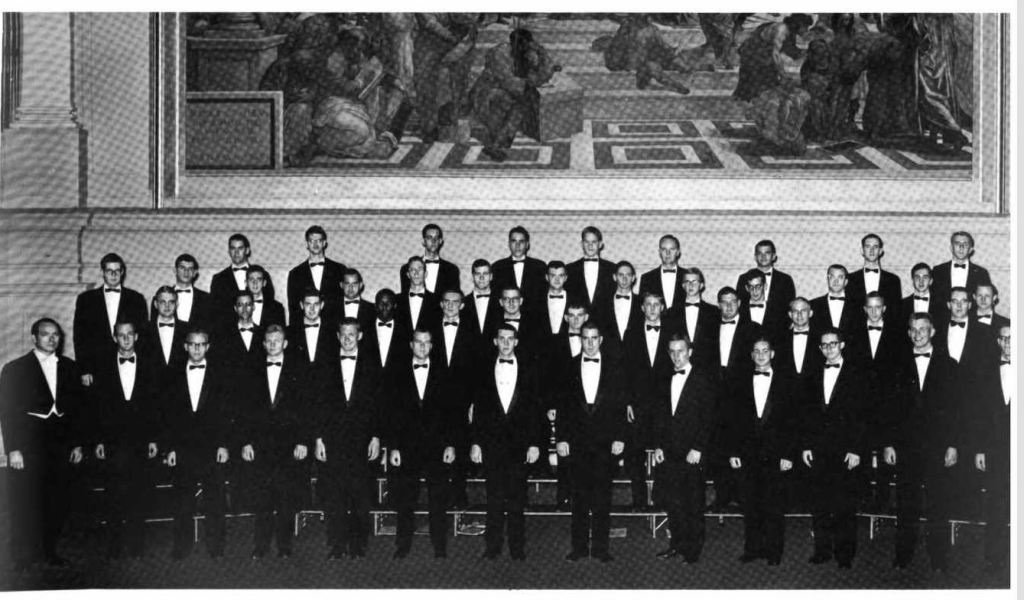
On Saturday afternoon, we were wrapping up a tour of Virginia Glee Club archives in the Small Special Collections Library at the University of Virginia. I had just taken about 50 alums, friends, conductors and family through the items, which I knew quite well having reviewed all of them—and donated some of them myself. We had also just ceremonially donated former Glee Club director Donald Loach‘s collection of concert programs to the library, and I was feeling pretty good about myself as a historian.
Then an alum asked a question that stopped me in my tracks. “Do you know who the first African-American member of Club was?”
After a pause, I replied, “No, but we should.”
The Virginia Glee Club is part of the larger story of the University of Virginia, and that story includes discrimination against African-Americans. It wasn’t until 1950 that Gregory Swanson, a graduate of Howard Law School, applied to take graduate courses at the University of Virginia, was denied admission, sued and won, becoming the first black student at the University—only to drop out in the summer of 1951. The University’s president, Colgate Darden, said he “was not well prepared for the work.” In the early 1950s two other African Americans followed in Swanson’s footsteps, and Walter N. Ridley became the first black student not only to gain a degree at the University but also the first black student to receive a doctorate from any Southern university.
It took the undergraduate schools a few more years, but in September 1955, following on the heels of the 1954 Brown vs. Board decision, three black students matriculated in the engineering school. Theodore Thomas and George Harris dropped out by the following spring, but Robert Bland continued on and was the first African-American undergraduate to graduate from the University in 1959, nine full years after the struggle for integration started. Also at the end of the fifties, Edgar F. Shannon took over as University president, and that’s when things started to get rolling.
I knew that the first black Glee Club member had to have joined sometime after 1959. I knew the story of David L. Temple, Jr., class of 1969, who was a member of Club from 1967 to 1969 and desegregated the fraternity system at the University, but I believed the first African-American member of Glee Club came earlier.
My second thought was that he would have joined during Don Loach’s first season as conductor, 1964-65. There’s a story in our archives that the Glee Club went on tour that fall, only to have their bus refused service in a truck stop on Route 29. After the tour, Loach raised the issue with President Shannon, and subsequently the truck stops got integrated. It’s a great story, and I assumed that this young man (whose name I’m still working on identifying; I have a bunch more candidates to work through with yearbook pictures) was the first student. (Update: I was closer than I thought. See below.) But as I was flipping through the 1965 yearbook, I found a picture of one of the graduating students of the Class of 1965 and knew we had found our candidate.
In 1961-1962, the group picture of the Glee Club for the first time has a black face. (That’s the picture up above.) The young man standing on the second row to the left side of the stage of Old Cabell Hall is Edwin S. Williams, of Smithfield. He stayed in the Glee Club for two seasons—as did most members, since it could only be taken as a graded course for two years—and completed his BA in chemistry, graduating with the class of 1965. And I believe, based on the evidence I have so far, that he was the first African-American member of the Virginia Glee Club.
There’s certainly more of his story to be told, and I will continue to look for more information. But one of my first questions is: if the truck stops on Rt 29 were first integrated in 1964-65, what did Williams do when the Glee Club got on a bus in 1961-62? I think we have a lot more to learn, but I’m glad we’ve taken the first step.
Update April 28: Donald Loach filled in the missing pieces by confirming that Edwin S. Williams was still in Glee Club in 1964-1965—was the baritone section leader, in fact—and was the Club man not served at the truck stop. So the stories are connected! And we need to fix our roster information.

Edwin S. Williams, baritone section leader 1964-65, was the man not served at the truck stop on 29, the man who won the right to be served after President Shannon delegated his associate, Paul Saunier to check it out. Result was the integration of all truck stops up and down Rt. 29.
Great post, Tim. And great clarification from Coach!